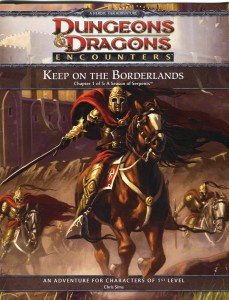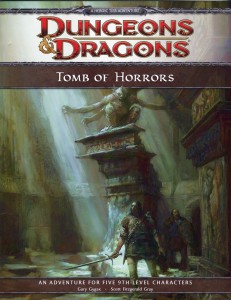 The show must to go on! Just because Ameron is on vacation is no excuse for Dungeon’s Master not to have a D&D Encounters weekly recap. I reached out to one of our loyal readers and he gratefully agreed to share his groups’ experiences with D&D Encounters week 6. Thanks to Rob Quinton (who you know as Lahrs, a frequent commenter at Dungeon’s Master) for his excellent summary of D&D Encounters week 6. Lahrs has been a player and a DM for the last twelve years and is currently running the D&D Encounters program at his FLGS.
The show must to go on! Just because Ameron is on vacation is no excuse for Dungeon’s Master not to have a D&D Encounters weekly recap. I reached out to one of our loyal readers and he gratefully agreed to share his groups’ experiences with D&D Encounters week 6. Thanks to Rob Quinton (who you know as Lahrs, a frequent commenter at Dungeon’s Master) for his excellent summary of D&D Encounters week 6. Lahrs has been a player and a DM for the last twelve years and is currently running the D&D Encounters program at his FLGS.
Author: Ameron (Derek Myers)
By now most players know, or should know, that a monster knowledge check can make all the difference when you’re fighting a monster for the very first time. Knowing that a monster is undead, has a vulnerability to fire or has a breath weapon will have a significant impact on what you do during the encounter. However, in practice I’ve discovered that making a monster knowledge check isn’t always as simple as rolling against the DCs set in the PHB. There are often other mitigating factors that need to be addressed when determining the success or failure of a monster knowledge check.
Any skill challenge that isn’t a challenge is boring. Here at Dungeon’s Master we’ve written a lot of articles about skill challenges. We’ve created a lot of skill challenge templates intentionally made generic enough that you can drop them right into an existing campaign. However, some skill challenges just aren’t that challenging to some parties. This is especially true as PCs get to higher levels. So what do you do if you find a skill challenge you want to use in your campaign but it’s not going to challenge your players? Simple, you make it more challenging – and we’ll tell you how.
Some DMs feel that skill challenges aren’t that malleable. They believe that skill challenges are designed with a certain level in mind and if you try to adjust the numbers for a party more than a couple of levels up or down it’s not going to work. I wholeheartedly disagree. With a little bit of creative thinking most skill challenge can be adapted to suit your party, regardless of the PCs’ current level.
 It looks like the LFR Global Admins have pretty much nailed how magic items will work after D&D Essentials becomes part of Living Forgotten Realms. Yesterday M. Sean Molley (posting as soccerref73) provided us with a preview in the article LFR Campaign Guide: Upcoming Magic Item Changes. Although the details are still not 100% finalized, this looks and sounds like a solid model and they pretty much say that in the article.
It looks like the LFR Global Admins have pretty much nailed how magic items will work after D&D Essentials becomes part of Living Forgotten Realms. Yesterday M. Sean Molley (posting as soccerref73) provided us with a preview in the article LFR Campaign Guide: Upcoming Magic Item Changes. Although the details are still not 100% finalized, this looks and sounds like a solid model and they pretty much say that in the article.
They’re never going to please everyone, but I think these changes sound fair and will please most of the people most of the time. They are still asking for your feedback so be sure to leave your comments. They’re especially concerned about gaps or loopholes that they might have missed.
 Chapter 2 of the Keep on the Borderlands – A Season of Serpents began this week. This season of D&D Encounters is running well at my FLGS. We’ve managed to run one solid table every week. On top of that new players keep coming out to try their hand at D&D. Some with absolutely no 4e D&D experience and other who are old pros looking for a pick-up game.
Chapter 2 of the Keep on the Borderlands – A Season of Serpents began this week. This season of D&D Encounters is running well at my FLGS. We’ve managed to run one solid table every week. On top of that new players keep coming out to try their hand at D&D. Some with absolutely no 4e D&D experience and other who are old pros looking for a pick-up game.
Even though we see new faces every week we’re having difficulty getting them all to come back. The good news is that the interest is there and that the players seem to be having a really good time (I know I am). The negativity that clouded our FLGS during the final weeks of D&D Encounters Dark Sun seems to have disappeared and we’re picking up a lot of positive momentum. I think we’ll start to see more regular attendance moving forward and perhaps have enough people to run two tables.
If you live in the Greater Toronto Area and want to join us, we play on Wednesday night at Dueling Grounds. D&D Encounters begins a 6 p.m. every week.
 The Tomb of Horrors. An adventure synonymous with character death. Its reputation for brutality is well known and often repeated in anything but hushed tones. Almost all D&D players have tried their hand at this iconic adventure at some point in their gaming career. So when an ambitious DM decided to gather experienced gamers, none of whom had ever actually played Tomb of Horrors before, and run them through the 4e re-imagining of the most brutal adventure ever written, he was surprised to actually find five experienced gamers who fit this criteria. A sixth player who had recently run the Tomb of Horrors for the kids at D&D Camp filled the sixth seat but agreed not to be the party’s decision-maker. With the party complete, the adventure begins.
The Tomb of Horrors. An adventure synonymous with character death. Its reputation for brutality is well known and often repeated in anything but hushed tones. Almost all D&D players have tried their hand at this iconic adventure at some point in their gaming career. So when an ambitious DM decided to gather experienced gamers, none of whom had ever actually played Tomb of Horrors before, and run them through the 4e re-imagining of the most brutal adventure ever written, he was surprised to actually find five experienced gamers who fit this criteria. A sixth player who had recently run the Tomb of Horrors for the kids at D&D Camp filled the sixth seat but agreed not to be the party’s decision-maker. With the party complete, the adventure begins.
 There are more changes on the horizon for LFR. A couple of weeks ago in the article Will Essentials Ruin LFR? we talked about forthcoming changes to magical treasure and PC equipment necessitated by D&D Essentials. Last week Greg Marks (posting as Skerrit) one of the Global Admins for LFR posted another article on the Wizards forums announcing more changes to LFR. In the article CCG Update he talks about changes to the way adventures are going to be structured in 2011.
There are more changes on the horizon for LFR. A couple of weeks ago in the article Will Essentials Ruin LFR? we talked about forthcoming changes to magical treasure and PC equipment necessitated by D&D Essentials. Last week Greg Marks (posting as Skerrit) one of the Global Admins for LFR posted another article on the Wizards forums announcing more changes to LFR. In the article CCG Update he talks about changes to the way adventures are going to be structured in 2011.
 Last week Ronnik tried to eliminate any evidence that might tie him to the Cult of Tiamat or Gordi’s kidnapping. Time was of the essence, so the PCs headed to the Well Hideout specified on the map they found in Ronnik’s wall safe.
Last week Ronnik tried to eliminate any evidence that might tie him to the Cult of Tiamat or Gordi’s kidnapping. Time was of the essence, so the PCs headed to the Well Hideout specified on the map they found in Ronnik’s wall safe.
This week we had a full party of six made up of Merric, Quinn, Hagen, Sola and two Berrians. After running two characters last week I opted to go back to just one character this week – Sola. We had a new player join our table this week. The last time he played D&D was AD&D 2e. So after a quick 10 minute primer on d20 mechanics, and a 5 minute recap of what happened during weeks 1-3 we moved on to D&D Encounters week 4.
When the party finds themselves in front of a locked door it usually falls to the Rogue to search for traps and then unlock it. It takes two rolls and about 30 seconds of game play. It’s a boring, even for the Rogue.
As a DM I’m always trying to find new and creative ways to challenge the party. On top of that, I like to throw typical conventions upside down. So when I was creating a recent dungeon and needed to place a “door” between the PCs and a secret chamber I opted for something unconventional. I wanted something that required more than a quick Thievery check to bypass. I also wanted something that required the entire party to work together to overcome. And that’s where the idea for the revolving door originated.
Depending on how a DM wasn’t to incorporate this into his campaign, it can be a straight up skill challenge or it can easily become a dangerous hazard. I’ll describe how the door works and then provide the skill challenge mechanics afterward.
When players create a character one of the most important decisions they make is choosing their race. Most often players look at the race that provides the best ability bonuses or most interesting racial power to compliment their class. It’s because of this min/maxing we tend to see the same race/class combos over and over again. Introducing the Metamorphosis Curse into your campaign will force players to try new races they might not otherwise choose on their own.
Let’s assume that you’ve created the perfect character. You’ve played through a few levels and you’re really getting to know this PC. He was built to kick butt and he’s doing a fantastic job so far. Everything’s clicking. What happens if his race is suddenly changed? How does this affect your character?